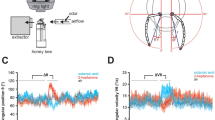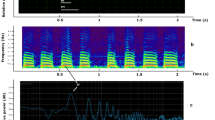Abstract
THE function of the antennae of insects as air current sense organs and their relationship to flight control has already been investigated by behavioural studies in flies, bees and locusts1–6, all of which are excellent fliers. The dragonfly is also an excellent flier although it possesses a very different flight apparatus7–9. Even though flight is apparently influenced by the eyes and the neck sense organs of the dragonfly10,11, it seems unlikely that these organs have anything to do with the control of movements which are dependent on the surrounding air for their stimulation. For the measurement of flying speed relative to the surrounding air, for example, one might expect that, just as in the other insects, the antennae play an important and specific role. It is this hypothesis which has been tested in the present work, the results of which are reported below.
This is a preview of subscription content, access via your institution
Access options
Subscribe to this journal
Receive 51 print issues and online access
$199.00 per year
only $3.90 per issue
Buy this article
- Purchase on Springer Link
- Instant access to full article PDF
Prices may be subject to local taxes which are calculated during checkout
Similar content being viewed by others
References
Burkhardt, D., Schneider, G., Z. Naturf., 12 b, 139–143 (1957).
Burkhardt, D., Gewecke, M., Cold Spring Harbor Symp. quant. Biol., 30, 601–614 (1965).
Heran, H., Z. vergl. Physiol., 42, 103–163 (1959).
Gewecke, M., Nature, 225, 1263–1264 (1970).
Gewecke, M., J. comp. Physiol., 80, 57–94 (1972).
Gewecke, M., in Experimental Analysis of Insect Behaviour, edit. by Barton Browne, L., 100–113 (Springer-Verlag, Berlin, 1974).
Chadwick, L. E., Bull. Brooklyn ent. Soc., 35, 109–112 (1940).
Russenberger, H., Russenberger, M., Mitt. naturf. Ges. Schaffhausen, 27, 1–88 (1959).
Neville, A. C., J. exp. Biol., 37, 631–656 (1960).
Mittelstaedt, H., Z. vergl. Physiol., 32, 422–463 (1950).
Hisada, M., Tamasige, M., Suzuki, N., J. Fac. Sci. Hokkaido Univ., (Ser. 6, Zool.), 15, 568–577 (1965).
Author information
Authors and Affiliations
Rights and permissions
About this article
Cite this article
GEWECKE, M., HEINZEL, HG. & PHILIPPEN, J. Role of antennae of the dragonfly Orthetrum cancellatum in flight control. Nature 249, 584–585 (1974). https://doi.org/10.1038/249584a0
Received:
Issue Date:
DOI: https://doi.org/10.1038/249584a0
This article is cited by
-
Palaeozoic giant dragonflies were hawker predators
Scientific Reports (2018)
-
Infrared video tracking of Anopheles gambiae at insecticide-treated bed nets reveals rapid decisive impact after brief localised net contact
Scientific Reports (2015)
-
Vision and air flow combine to streamline flying honeybees
Scientific Reports (2013)
-
Antennae in the hawkmoth Manduca sexta (Lepidoptera, Sphingidae) mediate abdominal flexion in response to mechanical stimuli
Journal of Comparative Physiology A (2010)
-
The flight maintenance mechanism in the cockroachPeriplaneta americana L.
Journal of Comparative Physiology A (1984)
Comments
By submitting a comment you agree to abide by our Terms and Community Guidelines. If you find something abusive or that does not comply with our terms or guidelines please flag it as inappropriate.



